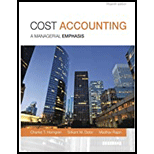
1.
Spending Variance:
Spending variance is the deviation of actual expenses from the budgeted expenses.
Efficiency Variance:
Efficiency variance is the distinction between actual quantity of input and estimated quantity of input purchased for a particular price.
Production-Volume Variance:
Production volume variance determines the amount of
Price Variance:
Price variance is the distinction between the estimated or budgeted price of the input material and actual price of the input material multiplied by actual volume of input.
Budgeted fixed overhead rate:
Budgeted fixed overhead rate is the sum total of estimated overhead cost divided by the total volume of budgeted cost allocation base.
To compute: a. Direct materials efficiency variance, b. direct materials rice variance, c. Direct labor efficiency variance, d. Direct labor price variance, e. Total manufacturing overhead manufacturing variance, f. Fixed overhead flexible
2.
To prepare: Gross margin for K Company’s first year of operation
Want to see the full answer?
Check out a sample textbook solution
Chapter 8 Solutions
EBK COST ACCOUNTING

 AccountingAccountingISBN:9781337272094Author:WARREN, Carl S., Reeve, James M., Duchac, Jonathan E.Publisher:Cengage Learning,
AccountingAccountingISBN:9781337272094Author:WARREN, Carl S., Reeve, James M., Duchac, Jonathan E.Publisher:Cengage Learning, Accounting Information SystemsAccountingISBN:9781337619202Author:Hall, James A.Publisher:Cengage Learning,
Accounting Information SystemsAccountingISBN:9781337619202Author:Hall, James A.Publisher:Cengage Learning, Horngren's Cost Accounting: A Managerial Emphasis...AccountingISBN:9780134475585Author:Srikant M. Datar, Madhav V. RajanPublisher:PEARSON
Horngren's Cost Accounting: A Managerial Emphasis...AccountingISBN:9780134475585Author:Srikant M. Datar, Madhav V. RajanPublisher:PEARSON Intermediate AccountingAccountingISBN:9781259722660Author:J. David Spiceland, Mark W. Nelson, Wayne M ThomasPublisher:McGraw-Hill Education
Intermediate AccountingAccountingISBN:9781259722660Author:J. David Spiceland, Mark W. Nelson, Wayne M ThomasPublisher:McGraw-Hill Education Financial and Managerial AccountingAccountingISBN:9781259726705Author:John J Wild, Ken W. Shaw, Barbara Chiappetta Fundamental Accounting PrinciplesPublisher:McGraw-Hill Education
Financial and Managerial AccountingAccountingISBN:9781259726705Author:John J Wild, Ken W. Shaw, Barbara Chiappetta Fundamental Accounting PrinciplesPublisher:McGraw-Hill Education





